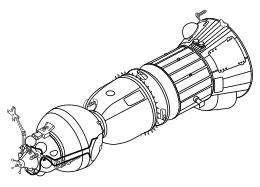Soyuz 7K-L3

Lunniy Orbitalny Korabl drawing
|
|
| Manufacturer | OKB-1 |
|---|---|
| Designer | Sergei Korolev |
| Country of origin | Soviet Union |
| Operator | Soviet space program |
| Applications | Manned cislunar flight and lunar orbit |
| Specifications | |
| Launch mass | 9,850 kilograms (21,720 lb) |
| Crew capacity | 2 |
| Dimensions | 10.06 meters (33.0 ft) length 2.93 meters (9.6 ft) diameter |
| Regime |
Low Earth orbit Cislunar space Lunar orbit |
| Production | |
| Status | Canceled |
| Built | 6 |
| Launched | 5 |
| Failed | 4 |
| First launch | December 2, 1970 |
| Last launch | November 23, 1972 |
| Related spacecraft | |
| Derived from | Soyuz 7K-OK |
| Derivatives |
Soyuz 7K-L1 lunar flyby Soyuz 7K-OKS space station shuttle |
| Flown with | LK lander |
The Soyuz 7K-LOK, or simply LOK (Russian: Lunniy Orbitalny Korabl meaning "Lunar Orbital Craft") was a Soviet manned spacecraft designed to launch men from Earth to circle the moon and developed in parallel to the 7K-L1. The LOK would carry two cosmonauts into orbit around the Moon, acting as "mother" spacecraft for the LK Lander, which would land one member of the crew to the surface. It was part of the N1-L3 programme which also included the LK lander and the N1 rocket.
Like the 7K-OK model, the 7K-LOK was divided into three sections, an ellipsoid Orbital Module, the "headlight"-shaped Descent Module, and a cylindrical equipment module. Like the 7K-OK, the 7K-LOK was capable of physically docking with another spacecraft, but lacked the transfer tunnel used on the Apollo (spacecraft), thus forcing the cosmonaut to make a spacewalk from the 7K-LOK's orbital module to the LK Lander using the new Krechet space suit (the predecessor to the Orlan space suits used today on the International Space Station).
Another change to the 7K-LOK was the elimination of the solar panels used on the 7K-OK, replacing them with fuel cells similar to those found on the Apollo CSM. Another feature, a "cupola" located on the Orbital Module, allowed the cosmonaut in the 7K-LOK to perform the docking procedure with the LK Lander after lunar liftoff. Only the Descent Module from the 7K-L1, with a thicker, reinforced heatshield, is used on the 7K-LOK and like the 7K-L1, is capable of doing a "skip reentry" so that the Soyuz could be recovered in the Soviet Union.
The information display systems (IDS) on the LOK were different from those of the Soyuz-7K. The Descent Module was equipped with the "Uran" control panel and the Orbital Module featured the "Orion" approach control panel.
...
Wikipedia
